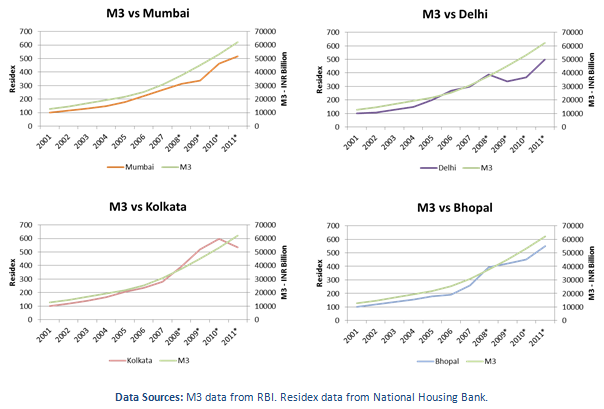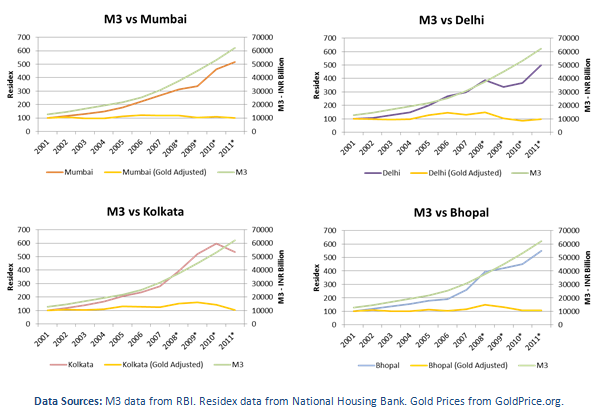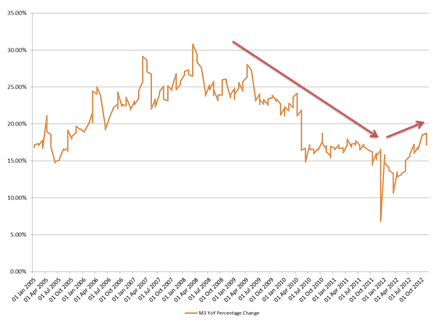By Saurabh Thirani of TheAustrian.in
There is a common myth which goes like this: “property prices do not fall”. Myths lead to misconceptions, and a common misconception is that real estate investments are supposed to be “as safe as houses”. This is a misnomer that the US housing crash of 2008 should have altered… but unfortunately it takes much more than a catastrophe to get rid of such calcified ideas.
 A data point that hasn’t got a great deal of coverage internationally is that of the decade-long gravity defying rise of the Indian real estate sector. To put it into perspective Indian real estate prices have increased by 5x–6x in most regions, and the speed of the price rise in India outstrips that of economies that had a housing bubble (such as Spain, Ireland and the US). This realty boom has all the makings of what could be a spectacular collapse… but the trouble is that most people are unwilling to see it.
A data point that hasn’t got a great deal of coverage internationally is that of the decade-long gravity defying rise of the Indian real estate sector. To put it into perspective Indian real estate prices have increased by 5x–6x in most regions, and the speed of the price rise in India outstrips that of economies that had a housing bubble (such as Spain, Ireland and the US). This realty boom has all the makings of what could be a spectacular collapse… but the trouble is that most people are unwilling to see it.
I first started warning of a housing bubble in India about a year back – in December 2011. That was when I had finished work on my book, Spot the Next Economic Bubble, which utilized the Austrian Business Cycle Theory (ABCT) as the cornerstone for analysis. There were next to no takers for my advice then. There are also very few takers today.
So does a real estate bubble really exist in India? And do my warnings about the impending disaster hold any water? Before examining this point in more detail, let’s first recap what the ABCT tells us about bubbles.
Before attempting to examine a bubble it is important to have a good definition for the phenomena so as to be able identify it clearly. According to Wikipedia, a bubble is defined as “trade in high volumes at prices that are considerably at variance with intrinsic values”. However this definition is difficult to work with, given that it is difficult to identify and observe the intrinsic value of an asset without the benefit of hindsight. Therefore most individuals attempt look at other tell-tale signs besides trade volumes and prices while analyzing bubbles, including factors such as manias, herd behavior, comparing extrapolation of future asset prices with historic data, moral hazard, etc. However, none of these approaches allow us to clearly define a bubble or attribute it to real and observable factors – and unless one is able to do that it would be always difficult to clearly identify a bubble.
The biggest advantage that the Austrian view offers is that it enables us to clearly define a bubble. According to Austrian economists, a bubble is a term used to define an activity that has sprung up on the back of loose monetary policies. The main factor behind bubbles is the fuel for speculation – which is low real interest rates. The fuel for speculation comes when the Central Bank expands credit by creating “mickey mouse” money out of thin air. “Mickey mouse” money has to go somewhere… and it fuels a speculative bubble where it does. Given that money is non-neutral, the early recipients of new money (or the first movers) always have an advantage since they are able to out-bit late recipients for goods and services. Additionally, these monetary injections act like a steroid given it turbo-charges activity in interest rate–sensitive sectors such as housing construction. Moreover, easy access to credit (enabled in part by monetary injections) also have a role to play in inflating bubbles, given that with the aid of leverages asset prices can be inflated beyond the wildest imagination. Therefore if you want to spot a bubble, you must first examine if asset prices are rising on account of increases in the money supply (and thus credit) or on account of genuine savings.
With this background let’s have a look at the conclusive evidence that suggests the existence of an Indian housing bubble. Towards this I reproduce the analysis I have included in my book Spot the Next Economic Bubble in the following section:
In the Indian context, there is strong evidence of an unprecedented growth in money supply where one has witnessed a double-digit year-on-year growth rate of broad money supply or M3 (see chart).
Liquidity has to go somewhere. In the case of India, this liquidity seems to have gone into the real estate market creating a false boom. A closer look at India’s real estate price data makes this more evident. India has a housing price index in the form of the Residex (maintained by National Housing Bank). Unlike the Case-Shiller Index in the US, the Residex does not provide consolidated data for the country as a whole. The National Housing Bank, on their website, reports data from 2007 onwards for a cross-section of 15 cities. Data from 2001 is available for only five Indian cities. Of the five cities covered since 2001 (including Delhi, Kolkata, Bangalore, Bhopal and Mumbai) by the Residex, real estate rates have been ‘soft’ at Bangalore. All other cities have shown and stellar growth in terms of house prices. The following graph shows the Residex data with the year 2001 as the base for four Indian cities – New Delhi, Mumbai, Bhopal and Kolkata (we will come back to Bangalore a little later). The primary Y-axis shows the percentage increase in the Residex, while the secondary Y-axis shows the broad money supply (or M3) in INR Billions as reported by the RBI for the same period:
Contrast housing prices for these four cities with the M3 for the same period to observe the similarity in price movements. This is not merely coincidental. This is a common pattern one would observe with any other asset bubbles.
What is actually driving the entire real estate party in India is the ever-increasing monetary injections into the economy by the RBI. Money created out of thin air is like a steroid which turbo-charges what is going on within an economy. Additionally, credit is like heroin where a little is never enough and more and more is needed to sustain the artificial high. Without monetary inflation, prices wouldn’t (or couldn’t) have increased at this pace. There is only one way to test if this theory does hold any water.
From the point of view of Austrian theories, the only thing in the world that preserves its value in the face of monetary infusion is gold . Towards this, let us attempt to adjust property prices with gold prices as the base (see below).
One cannot help notice that in inflation (or gold-adjusted terms), the property prices in India have remained flat for the most part of the previous decade. Mumbai, Bhopal and Kolkata have shown an approximate rise of 1%, 7% and 4% respectively, while Delhi has shown a dip of 3%.
The evidence available almost irrefutably points towards the fact that India is in a speculative bubble. While data does suggest and point towards a real estate boom in cities of New Delhi, Mumbai, Bhopal and Kolkata – the outlier Bangalore has had modest price increases during this period. But Bangalore did not miss the Indian real estate boom. Bangalore did have a real estate boom – but a boom of a different nature i.e. where supply increased enormously and consequently real estate prices didn’t.
There is something about human nature that resists bad news. Most people exhibit the ostrich mentality (of running away and avoid the topic) or turn to denial. This is true for most folks living in bubble economies where they attribute spectacular returns on assets to “strong fundamentals”. The most common response I have received is something like this: “There might be a slowdown in the Indian real estate sector… but a collapse in India is unlikely”. This is a flawed argument. In this section I present the various arguments that I have come across regarding my view, and show why these arguments are flawed.
Ostrich Argument #1: Cannot happen in India. We have a densely populated country with scarcity of land and growing demands for housing. While both these arguments appear to be logical, this fails to take into account historical evidence. The most spectacular real estate collapse in history occurred in Japan… and the scarcity and population density arguments were the same.
Ostrich Argument #2: India’s fundamentals are intact – and we needn’t fear a bust. Unfortunately this is also an argument that doesn’t seem to be grounded in reality. Closer examination of the ‘fundamentals’ of the Indian economy show Austrian boom patterns and paint a worrisome picture, specifically:
- Faltering GDP growth rate (expected to be sub-5% in 2012 fiscal – the lowest in a decade)
- High budget deficits. Increasing public debt. These would get worse in future owing to welfare (such as Direct Benefit Transfer based on the Aadhar card) and public works schemes (such as MGNREGA).
- Slowdown in industrial production as reflected by IIP data. Weak corporate performance by heavy industries in recent quarters.
- Chronic inflation and depreciating currency. An increasing trade deficit.
- Falling domestic savings rate (in single digits – the lowest in a decade).
- Increase of NPA’s on the balance sheets of domestic banks.
Which of these signs reflect prosperity or strong fundamentals? It is likely that the decades of monetary inflation have resulted in over-consumption and malinvestments and have distorted the capital structure of the Indian economy.
Ostrich Argument #3: A definite rise in prosperity as illustrated by sales of luxury cars and designer labels; swanky restaurants and malls. However consumption can never be taken as a sign of sustainable economic growth. A prosperous and growing economy is one that produces more goods, and not one which consumes more. Unfortunately these examples are more reflective of conspicuous consumption which manifests itself during a false boom. Monetary inflation tends to drive money into assets increasing the net worth of the super-rich, ultimately manifesting itself in the form of conspicuous consumption. Additionally, inflated asset prices makes people think they are richer than they really are, and the seemingly surplus funds are likely to get splurged on account of this money illusion. This too is consistent with ABCT.
Ostrich Argument #4: Lending standards of banks and financial services institutions are not lax. There may be an element of truth in this statement. Specifically the Reserve Bank of India (RBI) has imposed a Loan to Value Ratio of 80%, stepped in increased risk weights on housing loans, and increased standard asset provisions on teaser loans. However government regulations have never been able to prevent bubbles from occurring in the past (the case in point being the collapses of companies such as Enron and the US financial houses in 2008 – all of which operated in heavily regulated environments). Irrespective of the regulations in place, funds created by credit expansion out of thin air need to go somewhere, and given money is non-neutral it would fuel a speculative bubble in the process. Moreover, what goes un-noticed is that the realty boom has also in part been driven by the growing services sector in India – comprising of financial services, outsourcing, and media – all of which would come under heavy weather in the near future on account of global cues arising of the weakening of Western economies.
Ostrich Argument #5: Prices may fall – but not too much. This is the final argument offered when all other arguments are broken down. But the reality appears to be that people have short memories. Real estate that appeared to be over-priced in 2008 appears to be reasonable today given the constant monetary inflation which has fueled price rise. Unfortunately ABCT is also fairly categorical about what the eventual bust would bring with it. Following the end of an artificial boom asset prices are likely to return to pre-boom levels, or even below that. Price adjustment can be delayed through intervention in the form of stimulus, bail-outs, and through more monetary injections…. but cannot ever be prevented. A case in point is Japan which has seen ten rounds of monetary stimuli since their real estate bubble popped; but property prices are still way off the 1980 levels. Also, the attempts of preventing liquidation of poor investments through fiscal and monetary stimulus in the US following the 2008 crisis are less than convincing.
Ultimately one cannot think of any good arguments to refute the case against a bubble. It becomes more obvious if you were to analyze rental yields on housing. In India gross rental yields are around 2.68% in most metropolitan cities which are amongst the lowest in Asia . Asset prices disconnected with yields is the most evident tell-tale sign of a bubble.
The ABCT also helps us anticipate when an artificial boom is likely to come to a close. The trigger that will turn the artificial boom to bust is a cessation or even a marked deceleration in the rate of money creation. A slowdown in money creation causes interest rates rise and deprives the economy of its monetary heroin and bubbles begin to pop in the face of a liquidity crunch. Now this is what India’s M3 data shows: it confirms a visible slowdown in the rate of monetary injections (see chart).
According to theory the moment this happens the music will come to a stop slowing bubble activities that arose on the back of loose monetary policy. This is what the economy witnessed in part during the end of 2010 and early 2011 once the effect of the monetary steroid started wearing off.
Given the decline of economic activity, the RBI has attempted to gradually inflate using OMO. However this gradual expansion of M3 in H2 2012 is likely to be insufficient to prevent bubbles from collapsing.
There are very few bubbles which can be larger than a housing bubble (maybe with the exception of a bubble in government securities and currency). Housing bubbles are seldom innocuous given that they have a tendency to destabilize the entire banking sector. Specifically almost half the loans extended by banks in India to individuals are towards real estate. Specifically the exposure of the top 10 banks to real estate loans are estimated at approximately $90 Billion . The impact is likely to be more significant given that existing real estate is seldom mortgaged by businessmen to banks for raising funds for business expansion. Real estate prices in post-independence India has only gone one way – which is up – given the incessant monetary inflation brought under Socialistic and then Keynesian economic policies.
For those who have real estate investments in India, it might be advisable to stop dancing before the music comes to a sudden stop. And do remember that there is adequate historical proof that real estate prices can also fall – and it is unlikely that India will be a special case.
About the Author: Saurabh Thirani describes himself as a free-market liberal in the tradition of the Austrian School of economics. He is the author of Spot the Next Economic Bubble. Saurabh holds a degree in economics from St. Xavier’s College Kolkata, India; and an MBA from XLRI Jamshedpur, India. He lives in Kolkata, India. Connect with him via his website www.theaustrian.in or send him mail.
Carl Menger viewed money as an economic good just like any other good. But Menger considered money to be the most marketable economic good. Menger believed that money originated spontaneously as a result of market processes to overcome the limitations of the barter system, and ultimately it is the market that defines and chooses what would be acceptable in money. Markets have traditionally considered gold to be a marketable economic good and hence has been used as a store of value. Thus, Austrians do not consider gold to be a worthless yellow commodity. Instead gold is considered to be money.
Source http://www.globalpropertyguide.com/Asia/rent-yields as retrieved 28 December, 2012.





